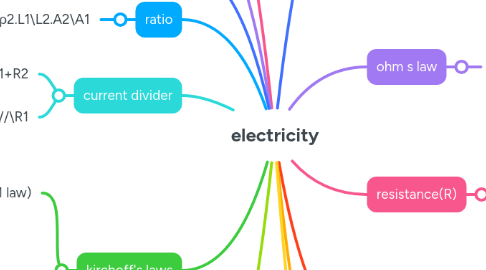
1. connecting resisting
1.1. series (I is const.)
1.1.1. Req = R1 + R2 + .... Rn
1.1.1.1. R connected in series of equal values: Req=NR
1.2. parallel (V is const.) (home devices connection)
1.2.1. Req = 1/{(1/R1)+(1/R2)+(1/R3).. +(1/Rn)}
1.2.1.1. R connected in parallel of equal values: Req =R\N
1.2.1.1.1. resistors in parallel equation: Req =R1.R2\R1+R2 product\sum
2. electric power(P)
2.1. it is the rate of doing work OR it is the energy consumed in one sec.
2.1.1. P=W\t (joule\sec)
2.1.1.1. P=VI=I2R ( I const. ) ( P∝R )=V2\R ( V const. ) ( P∝1\R ) (watt)
3. electric energy(work) (W)
3.1. W=Pt (watt.sec)
3.1.1. W=VIt=I2Rt=V2\R.t (joule)
4. ratio
4.1. R1\R2=ρ1\ρ2.L1\L2.A2\A1
4.1.1. R1\R2=ρ1\ρ2.L1\L2.(r2\r1)*2
4.1.1.1. R1\R2=ρ1\ρ2.L1\L2.(D2\D1)*2
5. current divider
5.1. I1=I//.R2\R1+R2
5.1.1. I2=I//.R1\R1+R2
5.2. I1=I//.R//\R1
5.2.1. I2=I//.R//\R2
6. kirchoff's laws
6.1. KCL(1 law)
6.1.1. ΣI(in)=ΣI(out)
6.1.2. ΣI=0
6.2. KVL(2 law)
6.2.1. ΣVB=ΣIR
6.2.1.1. step1: put the I arrows step2: put + & - at every component (VB,R0 step3: loop & ΣV=0 (begin at a point and return to same point)
6.2.2. ΣV=0
7. 2 batteries in series
7.1. I=VB1+VB2\Req+r1+r2 (same dir.)
7.2. I=VB1-VB2\Req+r1+r2 (opp dir.)
7.3. V=VB-I(R+r)
8. basic concepts
8.1. electric current(Q)
8.1.1. it is the flow of electric charges in a conducting material
8.1.1.1. Q=n.e-
8.2. electric current intensity(I)
8.2.1. it is the quantity of charges passed a given cross section in one sec.
8.2.1.1. I=Q\t
8.2.1.1.1. coulomb\sec. =ampere
8.3. potential difference(V)
8.3.1. it is the work done to transfer unit charge from one point to another
8.3.1.1. V=W\Q
8.3.1.1.1. joule\coulomb=volt
8.4. electromotive force(e.m.f.)(VB) الام
8.4.1. it is the total work done to transfer unit charge throughout the circuit outside and inside the source
8.4.1.1. outside & inside source (VB=10V) (Req+r)
8.5. P.D
8.5.1. from point to point (V1 , V2 ,V3) (R1, R2 ,R3)
8.6. terminal voltage
8.6.1. outside source (Vt=9V) (Req)
9. ohm s law
9.1. the current intensity in a conductor is directly propotional to the potential diffrence across its terminals at constant temperature
9.1.1. V=I.R (const. temperature) V∝I
10. resistance(R)
10.1. the ratio between the potential difference between the terminals of the conductor and the electric current intensity passing through it OR it is the opposition to the flow of electric current
10.1.1. R=V\I
10.1.1.1. volt\ampere or ohm or Ω
10.1.2. R = ρ L / A (const. temp.)
10.1.2.1. factors affecting: 1. resistivity of material (R∝n ρ) 2. length of conductor (R∝L) 3. cross-sectional area (R∝1\A)
11. resistivity(ρ)
11.1. it is numerically (not physically) equal to the resistance of a piece of material of length 1 meter and cross-sectional area 1 m2 at certain temperature
11.1.1. ρ = RA/l
11.1.1.1. Ω.m
11.1.1.1.1. kind of material
11.1.1.1.2. tempreture
12. conductivity(σ)
12.1. it is the reciprocal of resistivity OR it is reciprocal of resistance of a piece of material of length 1 m and cross-sectional area 1 m2 at certain temp.
12.1.1. σ=1\ρ
12.1.1.1. Ω-1.m-1
13. ohms law for closed circuit
13.1. V=VB-Ir
13.1.1. I=VB\Req+r
13.1.1.1. V=VB+Ir (charging battery)
13.1.1.1.1. V=VB ( I=0 , r=0 ) V<VB ( I flowing ) -ve V>VB (charging battery) +ve
